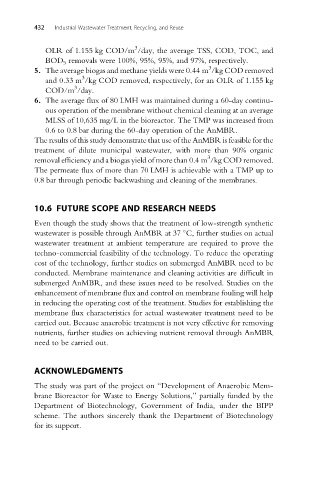Page 462 - Industrial Wastewater Treatment, Recycling and Reuse
P. 462
432 Industrial Wastewater Treatment, Recycling, and Reuse
3
OLR of 1.155 kg COD/m /day, the average TSS, COD, TOC, and
BOD 5 removals were 100%, 95%, 95%, and 97%, respectively.
3
5. The average biogas and methane yields were 0.44 m /kg COD removed
3
and 0.33 m /kg COD removed, respectively, for an OLR of 1.155 kg
3
COD/m /day.
6. The average flux of 80 LMH was maintained during a 60-day continu-
ous operation of the membrane without chemical cleaning at an average
MLSS of 10,635 mg/L in the bioreactor. The TMP was increased from
0.6 to 0.8 bar during the 60-day operation of the AnMBR.
The results of this study demonstrate that use of the AnMBR is feasible for the
treatment of dilute municipal wastewater, with more than 90% organic
3
removal efficiency and a biogas yield of more than 0.4 m /kg COD removed.
The permeate flux of more than 70 LMH is achievable with a TMP up to
0.8 bar through periodic backwashing and cleaning of the membranes.
10.6 FUTURE SCOPE AND RESEARCH NEEDS
Even though the study shows that the treatment of low-strength synthetic
wastewater is possible through AnMBR at 37 C, further studies on actual
wastewater treatment at ambient temperature are required to prove the
techno-commercial feasibility of the technology. To reduce the operating
cost of the technology, further studies on submerged AnMBR need to be
conducted. Membrane maintenance and cleaning activities are difficult in
submerged AnMBR, and these issues need to be resolved. Studies on the
enhancement of membrane flux and control on membrane fouling will help
in reducing the operating cost of the treatment. Studies for establishing the
membrane flux characteristics for actual wastewater treatment need to be
carried out. Because anaerobic treatment is not very effective for removing
nutrients, further studies on achieving nutrient removal through AnMBR
need to be carried out.
ACKNOWLEDGMENTS
The study was part of the project on “Development of Anaerobic Mem-
brane Bioreactor for Waste to Energy Solutions,” partially funded by the
Department of Biotechnology, Government of India, under the BIPP
scheme. The authors sincerely thank the Department of Biotechnology
for its support.

